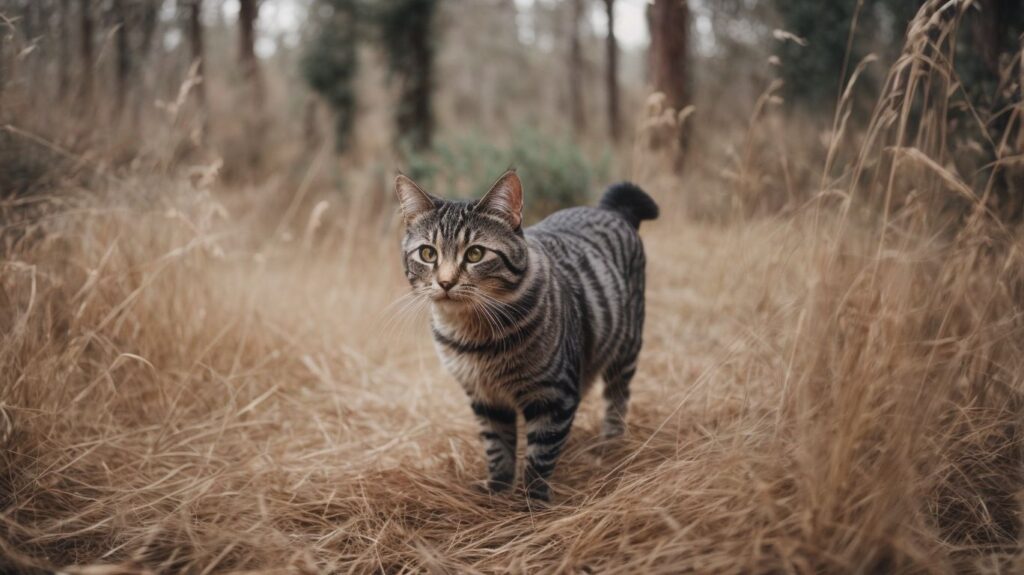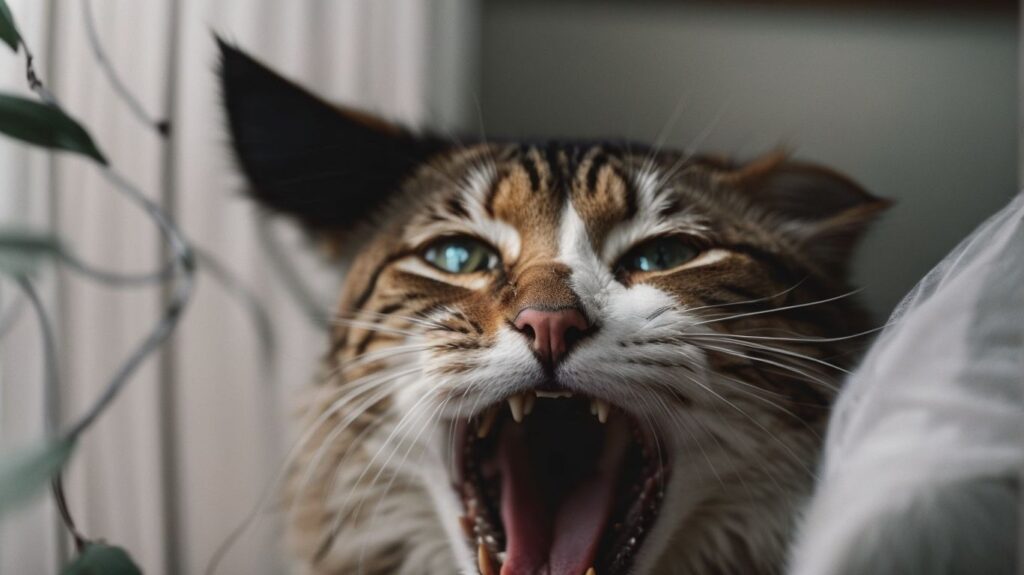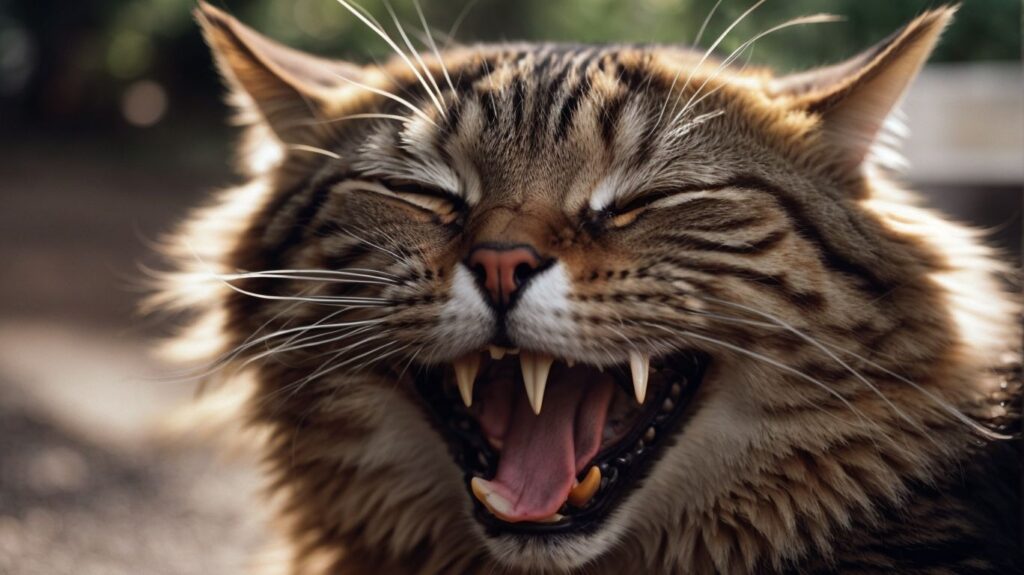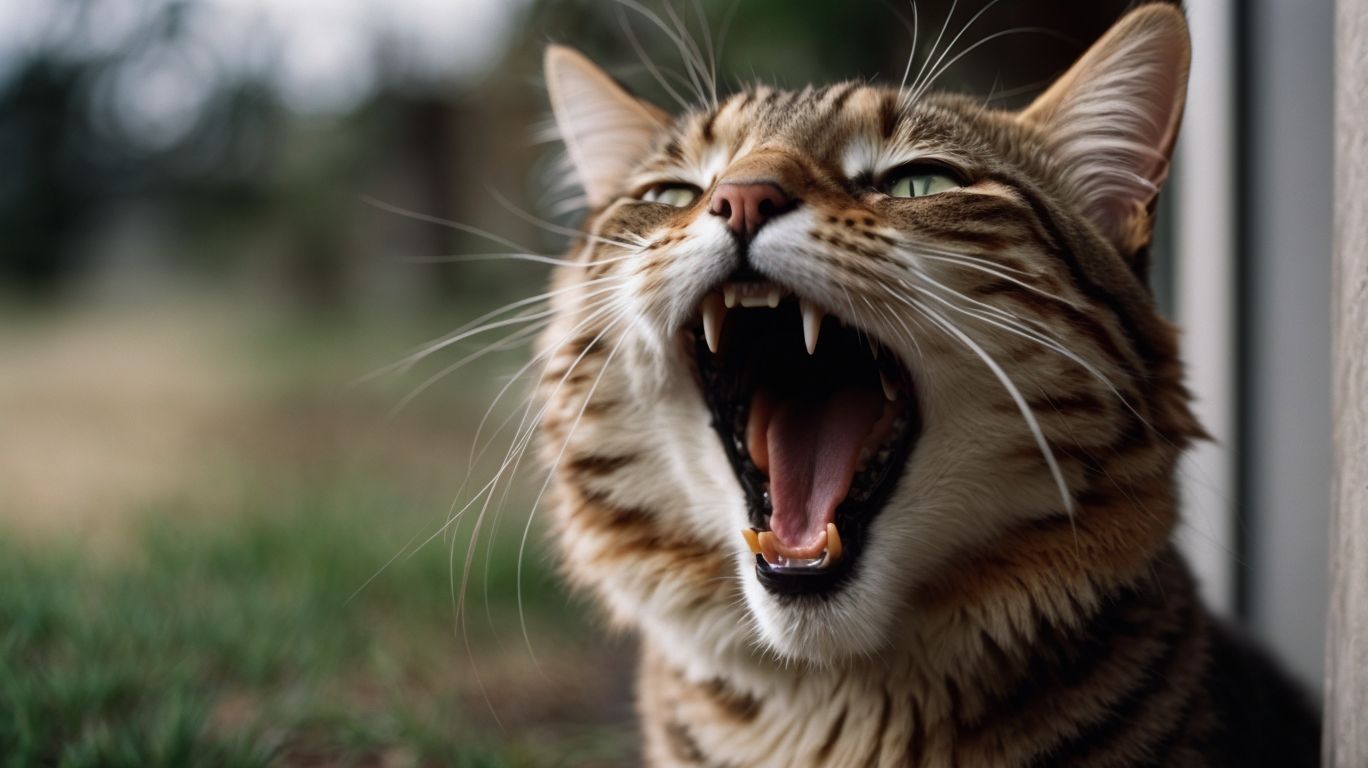Have you ever noticed your cat with its mouth open and wondered what it means? Cats typically keep their mouths closed, so seeing them with an open mouth can be a cause for concern. In this article, we will explore the various reasons why a cat may have its mouth open, from normal behavior to potential health issues. We’ll discuss common causes such as panting, heat regulation, stress or anxiety, dental issues, and respiratory problems. We’ll provide tips on how to distinguish between panting and simply having their mouth open, and what to do if your cat is panting.
We’ll share practical advice on how to help your cat cool down if it is panting, and when you should be concerned about your cat’s open mouth. We will offer preventative measures to keep your feline friend from panting or having its mouth open. If you’ve ever been curious about this behavior in your cat, this article will provide valuable insights and guidance.
What Does It Mean When a Cat Has Its Mouth Open?
When a cat has its mouth open, it could indicate various underlying reasons related to its health and behavior, including instances of open-mouth breathing, the flehmen response, and potential signs of respiratory distress.
Open-mouth breathing in cats may suggest elevated body temperature, stress, or a respiratory issue, prompting the need for veterinary attention.
The flehmen response is a behavior where the cat curls back its lips, inhales through the mouth, and holds the air, allowing the scent to reach the vomeronasal organ. This behavior often occurs in response to certain odors or pheromones, playing a role in scent communication and sexual behavior.
If a cat exhibits prolonged panting, excessive drooling, or struggles to breathe, it could be indicative of respiratory distress or underlying health problems. Cats typically do not pant as dogs do, therefore panting in cats should be regarded as abnormal and warrants immediate veterinary assessment.
Is It Normal for Cats to Have Their Mouths Open?

Cats opening their mouths is a natural behavior, often observed in the context of the flehmen response and other instinctive reactions to smell and pheromones.
When cats open their mouths, it allows them to draw in scents more effectively, particularly with the flehmen response where they expose the vomeronasal organ to the particles in the air.
This behavior is deeply ingrained in their instinctive nature as it helps them gather essential information about their environment, other animals, and potential mating partners. Cats are highly sensitive to pheromones, and opening their mouths is a way for them to enhance their olfactory perception, aiding in communication and navigating their surroundings.
What Are the Possible Reasons for a Cat to Have Its Mouth Open?
Cats may open their mouths for various reasons, including the flehmen response to smell something, potential signs of respiratory distress, and instances related to dental disease or oral discomfort.
The flehmen response is a behavior often observed in cats where they open their mouths to draw in scents, transferring them to the vomeronasal organ, also known as Jacobson’s organ, in the roof of their mouth. This action helps them better analyze and understand certain odors, especially those relating to pheromones.
Respiratory distress, on the other hand, can cause a cat to pant, wheeze, or breathe with its mouth open as it struggles to take in air. Dental issues such as gingivitis, broken teeth, or oral tumors can also lead to mouth opening as a sign of pain or discomfort.
Panting
Panting in cats involves the act of holding their mouths open, often indicating the presence of respiratory distress or heat regulation, which requires prompt attention and assessment by a veterinarian.
Cats usually pant to regulate their body temperature when they are exposed to high temperatures, feel stressed, or engage in vigorous physical activities. It is essential to distinguish between normal and abnormal panting; excessive or prolonged panting can be a sign of an underlying medical issue, such as feline respiratory problems, dehydration, heart disease, or lung conditions. Cat owners should be attentive to irregular panting and recognize it as an indicator for seeking professional veterinary care.
Heat Regulation
Cats may hold their mouths open as part of their natural heat regulation mechanism, allowing for increased airflow and cooling during elevated temperatures or environmental conditions.
Open-mouth behavior in cats plays a crucial role in their ability to regulate body temperature, especially in warm climates. By panting and holding their mouths open, cats are able to release excess heat from their bodies, much like how dogs pant. This behavior helps them to dissipate heat and maintain an optimal body temperature. The presence of special blood vessels in the mouth and tongue area aids in heat exchange and thermal regulation. Cats have adapted to seek out cooler spots in their environment, such as shaded areas or cooler surfaces, to aid in their heat management.
Stress or Anxiety
Cats may exhibit open-mouth behavior as a response to stress or anxiety, signifying a need for observation and potential interventions to address underlying triggers and promote feline well-being.
This behavior, often overlooked or misunderstood, can manifest in various ways, including excessive panting, open-mouth breathing, or excessive drooling. These signs may indicate discomfort or unease, warranting a closer look at potential environmental stressors, such as changes in routine, new additions to the household, or conflicts with other pets.
Understanding the link between open-mouth behavior and feline stress or anxiety can help cat owners and caregivers identify early warning signs and implement effective management strategies. Creating a calm and predictable environment, providing adequate hiding spots, and offering interactive play sessions can alleviate stress and reduce the likelihood of open-mouth behaviors in cats.
Dental Issues
Cats holding their mouths open may indicate underlying dental issues or oral discomfort, necessitating prompt evaluation and treatment by a veterinarian to address potential dental diseases and ensure optimal feline oral health.
Recognizing the significance of a cat’s oral health is crucial as dental problems can lead to pain, difficulty eating, and other health issues. Regular veterinary check-ups play a vital role in identifying and addressing potential dental diseases early. The buildup of tartar, gingivitis, and periodontal disease are common culprits in feline dental issues. Proper dental care and maintenance, such as tooth brushing, dental diets, and professional cleanings, can significantly improve a cat’s oral health and overall well-being.
Respiratory Problems
Cats holding their mouths open may be indicative of underlying respiratory problems, necessitating an urgent veterinary evaluation to address potential respiratory distress and ensure optimal feline respiratory health.
Open-mouth behavior in cats can often signal issues such as asthma, allergies, or upper respiratory infections, which, if left untreated, can lead to more serious health complications. Recognizing these signs and seeking timely veterinary care is crucial in preventing long-term damage to the respiratory system and maintaining overall well-being in feline companions.
A vet consultation can provide a comprehensive assessment, including local diagnostic imaging and breathing tests, to accurately diagnose and address the root cause of feline respiratory distress.
How Can You Tell If Your Cat is Panting or Just Has Its Mouth Open?

Distinguishing between cat panting and open-mouth behavior requires careful observation of respiratory patterns and associated signs, such as rapid breathing or visible efforts to breathe, to determine the underlying respiratory status of the feline.
When a cat is panting, you may notice rapid and shallow breaths, often accompanied by the visible expansion of the chest and an open mouth. Panting in cats can also be associated with spread-out elbows as the feline attempts to stabilize its body for effective breathing.
On the other hand, open-mouth behavior might manifest as the cat sitting with its mouth slightly open, without rapid breathing. It’s essential to note that open-mouth behavior is not usually indicative of panting and may be a sign of discomfort, stress, or heat regulation.
What Should You Do If Your Cat is Panting or Has Its Mouth Open?

If your cat is panting or holding its mouth open, it is crucial to seek immediate veterinary attention, as these behaviors may signify potential respiratory distress or other emergent medical conditions that require prompt evaluation and intervention.
While panting or open-mouth behavior in cats can be caused by heat, stress, or strenuous activity, persistent or exaggerated panting could indicate an underlying health issue. Respiratory problems, heart disease, or heat stroke are just a few of the serious conditions that could lead to these behaviors in cats. Therefore, it is imperative to have your cat assessed by a veterinarian to determine the underlying cause and provide appropriate treatment without delay.
How Can You Help Your Cat Cool Down If It is Panting?
In cases of cat panting, you can help your pet cool down by providing fresh water, creating a cool environment, and using a wet towel to assist in regulating its body temperature and easing the panting response.
Hydration is key when it comes to helping a panting cat. Ensure that they have access to clean, fresh water at all times, especially during warmer weather or after physical activity. Making adjustments to the environment can make a significant difference. Keep the indoor temperature comfortable and provide shaded areas for outdoor cats.
Using a wet towel can also be a simple and effective cooling technique. Gently place the damp towel over your cat, allowing the evaporative cooling to help lower their body temperature. Be mindful of not making it too cold, and always monitor your pet’s response.
Provide Fresh Water
Offering fresh water to your cat is essential for aiding in the cooling process, ensuring proper hydration and facilitating the reduction of panting due to elevated body temperature.
Hydration is crucial for maintaining normal body temperature in cats. Water enables cats to regulate their temperature through panting, a natural response to heat. When a cat pants excessively, it is a clear indication of the need for more water. Dehydration can lead to severe health issues, such as urinary problems and kidney disease.
Therefore, consistently providing access to fresh water is an important aspect of responsible pet ownership. As cats do not always drink enough water on their own, it is important to encourage them to stay hydrated, especially during warmer weather. Providing multiple drinking stations and using a clean, wide bowl can help stimulate their drinking habits.
Create a Cool Environment
Establishing a cool and comfortable environment for your cat can aid in reducing panting, ensuring optimal temperature regulation and promoting feline comfort and well-being.
Temperature management is crucial for cat owners, especially during hot weather or in homes with inadequate ventilation. Providing shaded areas, adequate air circulation, and access to cool surfaces can make a significant difference in preventing overheating and excessive panting.
Consider investing in cat-friendly cooling mats or beds to offer a cool spot for your feline friend to rest. These measures contribute to a stress-free environment and contribute to your cat’s overall comfort and health.
Use a Wet Towel
Utilizing a wet towel can help in cooling down a panting cat, as the moisture aids in dissipating heat and promoting thermoregulation, contributing to alleviating the panting response.
One of the key benefits of using a wet towel for a panting cat is that it emulates the natural cooling mechanisms of a feline’s body. When a cat is panting, it’s a sign that its body is trying to regulate its temperature. The wet towel provides a cooling sensation and supports the cat’s natural cooling process. It helps in preventing overheating and potential heatstroke, especially during hot weather.
When Should You Be Concerned About Your Cat’s Open Mouth?

You should be concerned about your cat’s open mouth when it is accompanied by signs of respiratory distress, prolonged open-mouth breathing, or any noticeable changes in your pet’s behavior or well-being, prompting the need for immediate veterinary evaluation and intervention.
Respiratory distress in cats can manifest as increased respiratory rate, labored breathing, or panting. Any behavioral changes such as lethargy, lack of appetite, or irritability could be red flags indicating something more serious. Cats are excellent at masking their discomfort, so any deviation from their normal behavior should be taken seriously.
Open-mouth breathing in cats is not normal and can indicate an underlying issue related to the respiratory or cardiovascular systems, such as feline asthma, heart disease, or respiratory infection. It’s crucial to seek prompt veterinary assessment to prevent potential worsening of the condition and to facilitate effective treatment.
When a cat displays open mouth breathing, it’s essential not to delay seeking veterinary care. This behavior can indicate a range of potential health issues, including but not limited to upper respiratory infections, heart disease, or feline asthma. Prompt evaluation and intervention by a veterinarian are critical to ensuring the well-being and quality of life for your feline companion.
How Can You Prevent Your Cat from Panting or Having Its Mouth Open?
Preventing cat panting and open-mouth behaviors involves maintaining feline health, minimizing stress, and addressing potential triggers, necessitating regular veterinary care and attentive management to promote overall well-being and prevent respiratory issues.
Regular physical activity and a balanced diet are crucial elements in maintaining feline health, thereby reducing the likelihood of respiratory distress. Creating a serene and comfortable environment at home can help alleviate stress, alongside providing enriching activities such as interactive toys and cozy resting spots.
Vet check-ups play a pivotal role in identifying any underlying health concerns early on, while also ensuring that your cat’s respiratory system is functioning optimally. By proactively addressing these factors, you can help mitigate the development of panting and open-mouth behaviors in your feline companion.
Frequently Asked Questions
When a cat has its mouth open, it usually means that they are panting due to exertion or heat. However, it can also be a sign of stress or pain.
Yes, it is completely normal for a cat to have its mouth open while sleeping. Cats often sleep with their mouths open to regulate their body temperature.
Your cat may keep its mouth open after eating to help cool down its body temperature. This is especially common in warmer weather or after eating a large meal.
Yes, cats can breathe with their mouths open. However, it is not their preferred method of breathing and may indicate an underlying health issue if done frequently.
Cats have a keen sense of smell and having their mouth open does not significantly affect their ability to smell. However, it may affect their ability to accurately locate the source of a scent.
It is not normal for a cat to constantly have its mouth open and it may be a sign of an underlying issue such as respiratory infection or dental problems. It is best to consult a veterinarian if your cat is constantly displaying this behavior.

